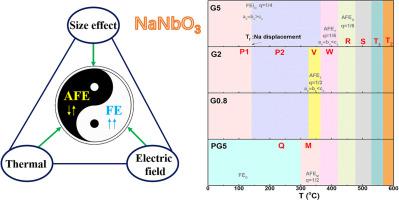Acta Materialia ( IF 8.3 ) Pub Date : 2023-02-15 , DOI: 10.1016/j.actamat.2023.118778 He Qi , Ge Wang , Yongcheng Zhang , Dawei Wang , Hui Liu , Shiqing Deng , Ruzhong Zuo , Jun Chen

|
Large polarization and strain change during antiferroelectric - ferroelectric phase transition under electric field is the foundation for realizing excellent electrical properties in antiferroelectric ceramics, therefore, the adjustment of antiferroelectricity and clarification of the corresponding mechanism is the foundation for controlling electrical properties. NaNbO3 is the most complex perovskite system showing multiple antiferroelectric phases in a wide temperature range, in which the antiferroelectricity shows obvious instability with changing external and internal conditions, namely the antiferroelectric phase can be adjusted by grain-size effect, electric field and heat treatment. According to the systematical study in terms of the Rietveld refinement of synchrotron XRD and Raman, NaNbO3 exhibits a ferrielectric P21ma structure at room temperature, the ferroelectric component of which increases with decreasing grain size. Two antiferroelectric tetragonal phases exist around Curie temperature TC before the entrance of antiferroelectric R phase zone, while an antiferroelectric monoclinic phase, which can be maintained to room temperature by annealing treatment, acts as the bridge for the depolarization of the poled NaNbO3 with ferroelectric Q phase. A detailed phase diagram mainly focused on the antiferroelectric phase zones of NaNbO3 is plotted, which gives a clear understanding about the polymorphic phase transitions under different conditions. The results concluded in this work would give a clear guidance for designing high-performance NaNbO3-based lead-free ceramics from the point of structure.
中文翻译:

通过晶粒尺寸效应、电场和热处理实现 NaNbO3 陶瓷的可调相结构
电场作用下反铁电-铁电相变过程中较大的极化和应变变化是反铁电陶瓷实现优异电学性能的基础,因此调节反铁电性和阐明相应的机理是控制电学性能的基础。NaNbO3是最复杂的钙钛矿体系,在很宽的温度范围内显示出多个反铁电相,其中反铁电性随内外条件的变化表现出明显的不稳定性,即反铁电相可以通过晶粒尺寸效应、电场和热处理进行调节。根据对同步加速器XRD和Raman的Rietveld精修方面的系统研究,NaNbO3在室温下呈现亚铁电P21ma结构,其铁电成分随着晶粒尺寸的减小而增加。在反铁电R相区进入前,在居里温度TC附近存在两个反铁电四方相,而通过退火处理可保持至室温的反铁电单斜相充当了极化NaNbO3与铁电Q相去极化的桥梁. 绘制了主要关注 NaNbO3 的反铁电相区的详细相图,可以清楚地了解不同条件下的多晶型相变。这项工作得出的结果将从结构的角度为设计高性能 NaNbO3 基无铅陶瓷提供明确的指导。其铁电成分随着晶粒尺寸的减小而增加。在反铁电R相区进入前,在居里温度TC附近存在两个反铁电四方相,而通过退火处理可保持至室温的反铁电单斜相充当了极化NaNbO3与铁电Q相去极化的桥梁. 绘制了主要关注 NaNbO3 的反铁电相区的详细相图,可以清楚地了解不同条件下的多晶型相变。这项工作得出的结果将从结构的角度为设计高性能 NaNbO3 基无铅陶瓷提供明确的指导。其铁电成分随着晶粒尺寸的减小而增加。在反铁电R相区进入前,在居里温度TC附近存在两个反铁电四方相,而通过退火处理可保持至室温的反铁电单斜相充当了极化NaNbO3与铁电Q相去极化的桥梁. 绘制了主要关注 NaNbO3 的反铁电相区的详细相图,可以清楚地了解不同条件下的多晶型相变。这项工作得出的结果将从结构的角度为设计高性能 NaNbO3 基无铅陶瓷提供明确的指导。在反铁电R相区进入前,在居里温度TC附近存在两个反铁电四方相,而通过退火处理可保持至室温的反铁电单斜相充当了极化NaNbO3与铁电Q相去极化的桥梁. 绘制了主要关注 NaNbO3 的反铁电相区的详细相图,可以清楚地了解不同条件下的多晶型相变。这项工作得出的结果将从结构的角度为设计高性能 NaNbO3 基无铅陶瓷提供明确的指导。在反铁电R相区进入前,在居里温度TC附近存在两个反铁电四方相,而通过退火处理可保持至室温的反铁电单斜相充当了极化NaNbO3与铁电Q相去极化的桥梁. 绘制了主要关注 NaNbO3 的反铁电相区的详细相图,可以清楚地了解不同条件下的多晶型相变。这项工作得出的结果将从结构的角度为设计高性能 NaNbO3 基无铅陶瓷提供明确的指导。可以通过退火处理保持到室温,作为铁电Q相极化NaNbO3去极化的桥梁。绘制了主要关注 NaNbO3 的反铁电相区的详细相图,可以清楚地了解不同条件下的多晶型相变。这项工作得出的结果将从结构的角度为设计高性能 NaNbO3 基无铅陶瓷提供明确的指导。可以通过退火处理保持到室温,作为铁电Q相极化NaNbO3去极化的桥梁。绘制了主要关注 NaNbO3 的反铁电相区的详细相图,可以清楚地了解不同条件下的多晶型相变。这项工作得出的结果将从结构的角度为设计高性能 NaNbO3 基无铅陶瓷提供明确的指导。


















































 京公网安备 11010802027423号
京公网安备 11010802027423号